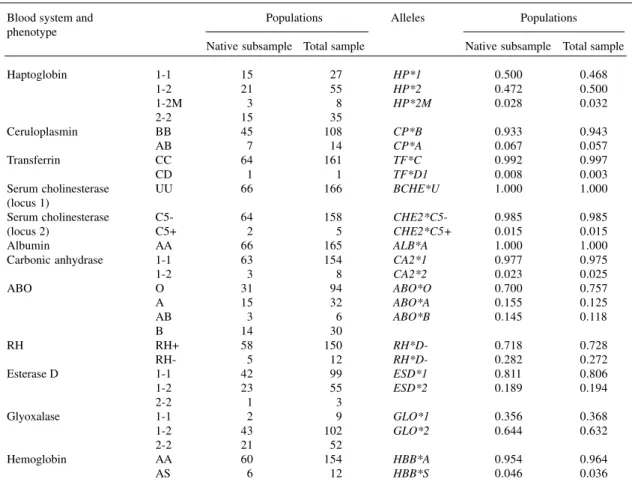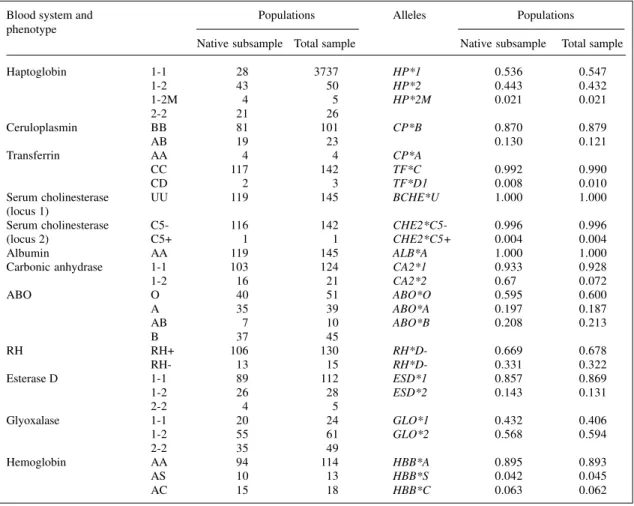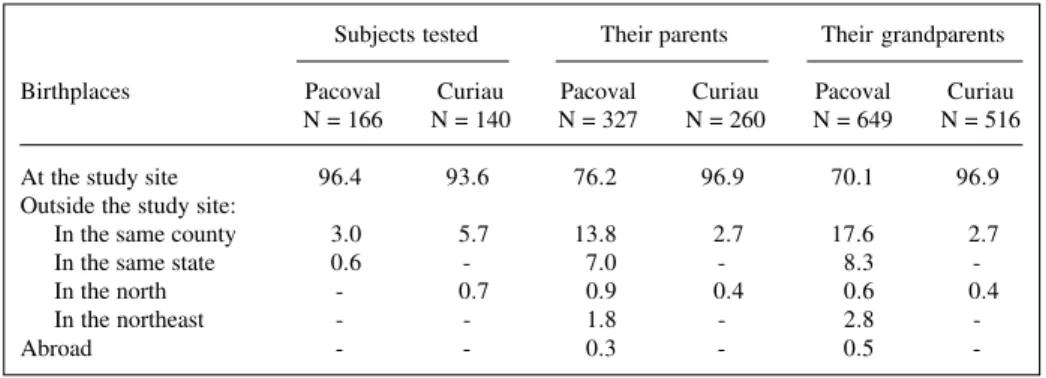INTRODUCTION
The slave trade brought at least 53,000 black Afri-cans to the Amazon region. They were imported directly from Africa by the General Company of Great Pará and Maranhão, private individuals, as well as indirectly through internal trade from other Brazilian regions such as Maranhão, Bahia, Pernambuco and Rio de Janeiro (Vergolino-Henry and Figueiredo, 1990). Historical records about the slave trade to the northern region indicate that most Africans were brought from Angola, Mozambique, Kenya and Tanzania, whereas a smaller number was brought from Guine-Bissau and Cape Verde. In addition, there are records of a small number of slaves from French Guyana and Surinam introduced to the region (State of Amapá and Marajó Archipelago). Some were victims of the illegal slave trade, while others came as fugitives (Curtin, 1969; Vergolino-Henry and Figueiredo, 1990).
Following the example of other Brazilian regions and South American countries, several communities named mocambos or quilombos were founded in the Amazon re-gion by escaped slaves, particularly in the State of Pará, a point of entry of African slaves to the region. Many of these communities still remain relatively isolated, and much of their identity is preserved.
Several genetic studies have been performed in
populations descended from Africans in the Amazon re-gion of Brazil and Venezuela evaluating the level of isola-tion and mobility, and quantifying the gene contribuisola-tion from non-blacks among them. In this study we report ge-netical (12 blood genetic systems), gege-netical-demographic (estimates of interethnic admixture) and demographic (mi-gration) data from two populations of predominantly Af-rican ancestry in the Brazilian Amazon region.
MATERIAL AND METHODS
The mocambo of Pacoval, formed by fugitive slaves from farms of the neighboring municipality of Santarém, is located in the rural area of the county of Alenquer, along the right margin of the Curuá River, in the northwestern region of the State of Pará, at about 2oS, 55oW. Blood samples from 166 individuals were collected (63% females, ages varying from seven to 86 years).
Curiau is located in the metropolitan region of Macapá, capital of the State of Amapá, northern Brazil, at about 0o, 51oW. From 1770 Curiau constituted a point of convergence of escaped slaves from the region, including slaves from Suriname and French Guyana (Muggiati, 1971). One hundred and forty-five individuals (49% males, ages varying from four to 84 years) were sampled.
Blood samples (10 ml) were collected with EDTA as an anticoagulant, and 12 genetic systems were analyzed: haptoglobin (HP), transferrin (TF), ceruloplasmin (CP), albumin (ALB), serum cholinesterase (loci 1 and 2), car-bonic anhydrase (CA2), esterase D (ESD), glyoxalase (GLO), hemoglobin (HB), ABO and RH blood groups. Phenotypic determinations were made employing classi-cal methods of horizontal and verticlassi-cal electrophoresis and
GENETICAL-DEMOGRAPHIC DATA FROM TWO AMAZONIAN POPULATIONS
COMPOSED OF DESCENDANTS OF AFRICAN SLAVES: PACOVAL AND CURIAU
João Farias Guerreiro1, Ândrea Kely Campos Ribeiro-dos-Santos1, Eduardo José Melo dos Santos1,
Antonio Carlos Rosário Vallinoto1, Izaura Maria Vieira Cayres-Vallinoto1, Gilberto Ferreira de Souza Aguiar2 and
Sidney Emanuel Batista dos Santos1
A
BSTRACTThe Amazon region of Brazil includes communities founded by escaped slaves, some of which still remain relatively isolated. We studied two such Afro-Brazilian communities (Pacoval and Curiau), in the rural area of Alenquer, Pará, and in the metro-politan region of Macapá, Amapá, respectively. Among 12 blood loci, alleles considered as markers of African ancestry, such as HBB*S, HBB*C, TF*D1, HP*2M, ABO*B, RH*D-, and CA2*2 were found at frequencies that are expected for populations with a predominantly African origin. Estimates of interethnic admixture indicated that the degree of the African component in Curiau (74%) is higher than that of Pacoval (44%); an Amerindian contribution was not detected in Curiau. Estimated values of African ancestry fit well with the degree of isolation and mobility of the communities. Pacoval exhibited a high proportion of immigrants among the parents and grandparents of the individuals studied, whereas persons living in Curiau exhibited a low level of mobility, despite its location in the metropolitan area of Macapá city, suggesting a relatively strong barrier against the interethnic admixture in this population. In addition, analysis of genetic data in a sub-sample consisting of individuals whose parents and grandparents were born in the study site, and that probably represents the populations two generations ago, indicated that gene flow from non-black people is not a recent event in both populations.
immunological tests that have been previously described or referenced (Santos et al., 1983; Schneider et al., 1987; Guerreiro et al., 1989).
Allele frequencies were estimated by the maximum likelihood method using the MAXLIK program developed by Reed and Schull (1968), and the degree of racial ad-mixture was estimated through the maximum-likelihood method of Krieger et al. (1965), using the GENIOC pro-gram.
RESULTS AND DISCUSSION
Blood polymorphisms
All phenotype and allele frequencies were in Hardy-Weinberg equilibrium in Curiau, whereas in Pacoval the HP and CP loci showed significant deviations from equi-librium (Tables I and II). Some alleles considered to be markers of African ancestry (HBB*S, HBB*C, TF*D1, HP*2M, ABO*B, RH*D-, and CA2*2) were found at fre-quencies that are expected for populations with a predomi-nantly African origin. Some unusual findings such as high frequencies of alleles ABO*B and HBB*C in Curiau, and
allele RH*D in both populations, which are higher than average frequencies estimated for black African popula-tions, may be attributed to microevolutionary factors (ge-netic drift and/or founder effect). In addition, the presence of the allele HBB*C in the Curiau sample (0.06) may also be attributed to the contribution of people from French Guyana to the formation of this population, since among the slaves brought to this country about 74% of them were from Senegambia and Guinea in West Africa (Curtin, 1969), where the HBB*C allele is relatively common. HBB*C was not found in Pacoval, nor in Trombetas or Cametá, two other communities of African descent in the Amazon region of Brazil (Schneider et al., 1987; Bortolini et al., 1992), but polymorphic frequencies were found in Curiepe and Panaquire, two Afro-Venezuelan populations (Bortolini et al., 1992; Castro de Guerra et al., 1996), and in various urban populations from the Brazilian Amazon characterized by a white + Amerindian + Afri-can contribution (Ayres et al., 1976; Santos et al., 1983, 1996; Cayres et al., 1991). Thus, these findings indicate that the contribution of people from West Africa to the formation of the Amazonian populations was heteroge-neous.
Table I - Observed phenotype and allele frequencies in Pacoval and its native subsample1.
Blood system and Populations Alleles Populations
phenotype
Native subsample Total sample Native subsample Total sample
Haptoglobin 1-1 15 27 HP*1 0.500 0.468
1-2 21 55 HP*2 0.472 0.500
1-2M 3 8 HP*2M 0.028 0.032
2-2 15 35
Ceruloplasmin BB 45 108 CP*B 0.933 0.943
AB 7 14 CP*A 0.067 0.057
Transferrin CC 64 161 TF*C 0.992 0.997
CD 1 1 TF*D1 0.008 0.003
Serum cholinesterase UU 66 166 BCHE*U 1.000 1.000
(locus 1)
Serum cholinesterase C5- 64 158 CHE2*C5- 0.985 0.985
(locus 2) C5+ 2 5 CHE2*C5+ 0.015 0.015
Albumin AA 66 165 ALB*A 1.000 1.000
Carbonic anhydrase 1-1 63 154 CA2*1 0.977 0.975
1-2 3 8 CA2*2 0.023 0.025
ABO O 31 94 ABO*O 0.700 0.757
A 15 32 ABO*A 0.155 0.125
AB 3 6 ABO*B 0.145 0.118
B 14 30
RH RH+ 58 150 RH*D- 0.718 0.728
RH- 5 12 RH*D- 0.282 0.272
Esterase D 1-1 42 99 ESD*1 0.811 0.806
1-2 23 55 ESD*2 0.189 0.194
2-2 1 3
Glyoxalase 1-1 2 9 GLO*1 0.356 0.368
1-2 43 102 GLO*2 0.644 0.632
2-2 21 52
Hemoglobin AA 60 154 HBB*A 0.954 0.964
AS 6 12 HBB*S 0.046 0.036
Interethnic admixture
Estimates of interethnic admixture obtained for the two populations (Table III) indicate that the degree of black component in Curiau is significantly higher than in Pacoval. These results fit well with the apparent morpho-logical classification of the individuals sample, which in-dicated 14% individuals with mixed ancestry in Curiau,
and 49% in Pacoval. Interethnic admixture values are also in accordance with the level of isolation and mobility of the two populations. The proportion of immigrants among the parents and grandparents of the individuals sampled in Pacoval is high, whereas Curiau, despite its location in the metropolitan area of Macapá city, exhibits a low level of mobility (Table IV), suggesting a relatively strong bar-rier against interethnic admixture in this population. The
Table II - Observed phenotype and allele frequencies in Curiau and its native subsample1.
Blood system and Populations Alleles Populations
phenotype
Native subsample Total sample Native subsample Total sample
Haptoglobin 1-1 28 3737 HP*1 0.536 0.547
1-2 43 50 HP*2 0.443 0.432
1-2M 4 5 HP*2M 0.021 0.021
2-2 21 26
Ceruloplasmin BB 81 101 CP*B 0.870 0.879
AB 19 23 0.130 0.121
Transferrin AA 4 4 CP*A
CC 117 142 TF*C 0.992 0.990
CD 2 3 TF*D1 0.008 0.010
Serum cholinesterase UU 119 145 BCHE*U 1.000 1.000
(locus 1)
Serum cholinesterase C5- 116 142 CHE2*C5- 0.996 0.996
(locus 2) C5+ 1 1 CHE2*C5+ 0.004 0.004
Albumin AA 119 145 ALB*A 1.000 1.000
Carbonic anhydrase 1-1 103 124 CA2*1 0.933 0.928
1-2 16 21 CA2*2 0.67 0.072
ABO O 40 51 ABO*O 0.595 0.600
A 35 39 ABO*A 0.197 0.187
AB 7 10 ABO*B 0.208 0.213
B 37 45
RH RH+ 106 130 RH*D- 0.669 0.678
RH- 13 15 RH*D- 0.331 0.322
Esterase D 1-1 89 112 ESD*1 0.857 0.869
1-2 26 28 ESD*2 0.143 0.131
2-2 4 5
Glyoxalase 1-1 20 24 GLO*1 0.432 0.406
1-2 55 61 GLO*2 0.568 0.594
2-2 35 49
Hemoglobin AA 94 114 HBB*A 0.895 0.893
AS 10 13 HBB*S 0.042 0.045
AC 15 18 HBB*C 0.063 0.062
1Native subsample: subjects whose parents and grandparents were born in the study site.
Table III - Interethnic admixture in Afro-Brazilian populations from the Amazon region (%).
Estimated admixture and standard error
Population Black White Amerindian Reference
Trombetasa 56.4±12.6 23.8±11.0 19.8±12.5 Bortolini et al. (1995)
Trombetasb 62.0± 5.0 27.0c± 11.0± 4.0 Schneider et al. (1987)
Cametáa 48.0± 0.7 17.9± 0.6 34.1± 0.7 Bortolini et al. (1992)
Cametáb 49.6± 12.9 18.0± 11.5 32.3±14.1 Bortolini et al. (1995)
Curiaub 73.6± 14.6 26.4±14.6 0 Present study
Pacovalb 44.3±11.7 27.4± 12.6 28.3±11.7 Present study
aMethod of Krieger et al. (1965). bMethod of Long et al. (1991). cThe authors did not furnish the
proportion of African ancestry obtained for Curiau is the highest reported among communities composed of descen-dants of black Africans thus far studied in the Amazon region (Table III). In addition, Curiau is the first Amazo-nian population where an Amerindian contribution was not detected.
In order to evaluate whether admixture with Cau-casians and Amerindians has occurred in the last two gen-erations, a subsample of subjects whose parents and grand-parents were born in the study site was analyzed. There where no significant differences (Tables I and II) with re-spect to the total sample (Pacoval: χ2 = 5.95, d.f. = 12, P = 0.91; Curiau: χ2 = 1.00, d.f. = 12, P = 1.00), indicating that admixture with non-blacks is not a recent event in both communities.
In summary, the genetic variability observed in Pacoval and Curiau is consistent with the African origin of the populations, with some degrees of local differentia-tion and admixture with people of Caucasian and/or Amerindian ancestry. In addition, the presence of people from West Africa among the African slaves brought to the Amazon region was well characterized by the occurrence of the allele HBB*C in Curiau.
RESUMO
A região amazônica brasileira abriga diversas comunidades formadas por descendentes de escravos africanos, algumas das quais ainda relativamente isoladas. Nós estudamos duas dessas comunidades (Pacoval e Curiau), localizadas na área rural do município de Alenquer, Pará, e na região metropolitana de Macapá, Amapá, respectivamente. Entre os 12 loci investigados, alelos considerados como marcadores de ancestralidade africana, tais como HBB*S, HBB*C, TF*D1,
HP*2M, ABO*B, RH*D- e CA2*2, foram encontrados com freqüências elevadas, de acordo com o esperado para populações com origem predominantemente africana. As estimativas de mistura racial indicaram que o percentual de contribuição africana em Curiau (74%) é maior do que em Pacoval (44%) e que em Curiau não foi detectada mistura com indígenas. As estimativas de ancestralidade africana estão de acordo com o grau de isolamento e com a mobilidade das comunidade estudadas.
Table IV -Birthplace distribution (in %) of the individuals studied in Pacoval and Curiau and that of their ancestors.
Subjects tested Their parents Their grandparents
Birthplaces Pacoval Curiau Pacoval Curiau Pacoval Curiau N = 166 N = 140 N = 327 N = 260 N = 649 N = 516
At the study site 96.4 93.6 76.2 96.9 70.1 96.9
Outside the study site:
In the same county 3.0 5.7 13.8 2.7 17.6 2.7
In the same state 0.6 - 7.0 - 8.3
-In the north - 0.7 0.9 0.4 0.6 0.4
In the northeast - - 1.8 - 2.8
-Abroad - - 0.3 - 0.5
-Pacoval apresenta um elevado percentual de imigrantes entre os pais e avós dos individuos estudados, enquanto que a comunidade de Curiau, apesar de situada na região metropolitana de Macapá, apresenta uma pequena proporção de imigrantes, sugerindo a existência de uma barreira relativamente forte contra a mistura interétnica. A análise dos dados genéticos foi também efetuada em sub-amostras constituídas apenas por indivíduos cujos pais e avós nasceram na localidade em estudo e que provavelmente representam essas populações duas gerações atrás. Os resultados indicaram que a mistura com não-negros nas duas populações não é um evento recente.
AKNOWLEDGMENTS
We are grateful to the communities studied for their col-laboration, and to Roberto A.N. Madeiro, Vilson C. Monteiro, Edson S. Abrahim Filho and Hailton O. Monteiro for assistance with the blood sample collection. This work was supported by UFPA and CNPq.
REFERENCES
Ayres, M., Salzano, F.M., Franco, M.H.L.P. and Barros, R.M.S. (1976). The association of blood groups, ABH secretion, haptoglobins and hemoglobins with filariosis. Hum. Hered. 26: 105-109.
Bortolini, M.C., Weimer, T.A., Franco, M.H.L.P., Salzano, F.M., Layrisse, Z., Schneider, H., Schneider, M.P.C. and Harada, M.L.
(1992). Genetic studies in three South American Black populations.
Gene Geogr. 6: 1-16.
Bortolini, M.C., Weimer, T.A., Salzano, F.M., Callegari-Jacques, S.M., Schneider H, Layrisse, Z. and Bonatto, S.L. (1995). Evolutionary relationships between Black South American and African popula-tions. Hum. Biol. 67: 547-559.
Castro de Guerra, D., Arvelo, H., Rodriguez-Larralde, A. and Salzano, F.M. (1996). Genetic studies in Panaquire, a Venezuelan population.
Hum Hered. 46: 323-328.
Cayres, I.M.V., Vallinoto, A.C.R., Ribeiro dos Santos, A.K.C., Santos, E.J.M., Guerreiro, J.F. and Santos, S.E.B. (1991). Variabilidade genética em populações humanas da Amazônia. Braz. J. Genet. 14
(Suppl.): 141 (Abstract).
Curtin, P.D. (1969). The Atlantic Slave Trade: A Census. University of Wisconsin Press, Madison.
Guerreiro, J.F., Aguiar, G.F.S. and Santos, S.E.B. (1989). Serum cho-linesterase polymorphism (CHE1 and CHE2 loci) among several In-dian groups from Amazon region of Brazil, and segregation of the C5 variant in families. Gene Geogr. 3: 11-20.
Yasuda, N. (1965). Racial admixture in north-eastern Brazil. Ann. Hum. Genet. 29: 113-125.
Long, J.C. (1991). The genetic structure of admixed populations. Genetics
127: 416-428.
Muggiati, A. (1971). O ultimo quilombo. Rev. Manchete9: 648-657.
Reed, T.E. and Schull, W.J. (1968). A general maximum likelihood method estimation program. Am. J. Hum. Genet. 20: 579-580.
Santos, S.E.B., Salzano, F.M., Franco, M.H.L.P. and Freitas, M.J.M.
(1983). Mobility, genetic markers, susceptibility to malaria and race mixture in Manaus, Brasil. J. Hum. Evol. 12: 373-381.
Santos, E.J.M., Ribeiro dos Santos, A.K.C., Guerreiro, J.F., Aguiar,
G.F.S. and Santos, S.E.B. (1996). Migration and ethnic change in an admixed population from the Amazon region (Santarém, Pará).
Braz. J. Genet. 19: 511-515.
Schneider, H., Guerreiro, J.F., Santos, S.E.B., Weimer, T.A., Schneider, M.P.C. and Salzano, F.M. (1987). Isolate breakdown in Amazonia: the blacks of the Trombetas River. Braz. J. Genet. 10: 565-574.
Vergolino-Henry, A. and Figueiredo, N. (1990). A presença africana na Amazônia colonial: uma notícia histórica. Arq. Público do Pará 1: 27-66.


